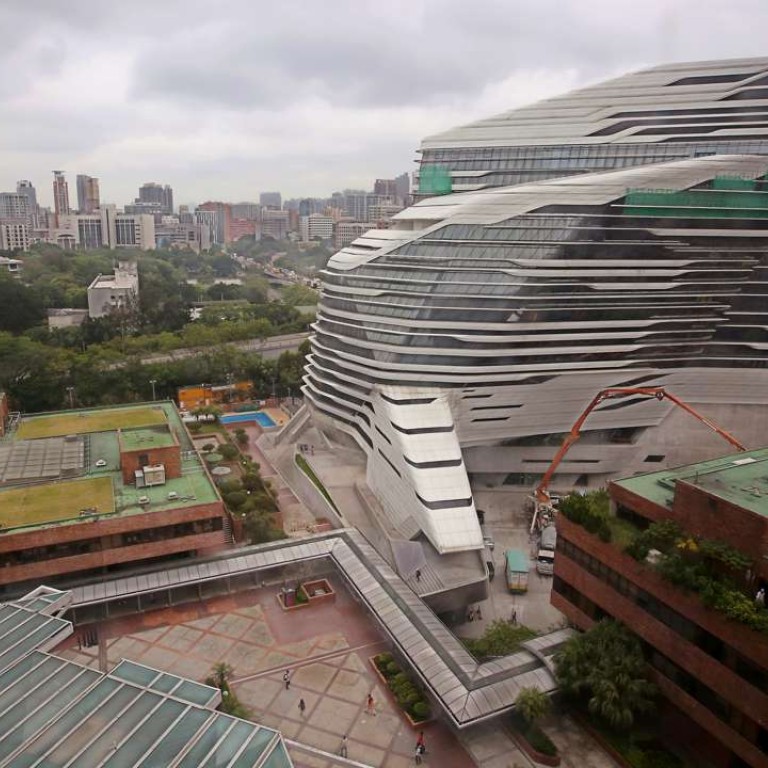
Change of tack: Hong Kong debate should switch from green roof plan submissions to aim of such projects, surveyor says
Veteran surveyor Vincent Ho says some green roof projects have negligible worth given high management and maintenance costs
Three slabs of grass sit atop Polytechnic University’s Shaw Amenities Building. The vegetation, about 150 millimetres thick and enclosed by barriers, appears dishevelled after a bout of rain. Dark blotches of moisture stain the perimeter.
The Hung Hom campus boasts eight such “green roofs”, five of them with Buildings Department approval. Three, including the one at the amenities centre, do not.
The question of whether or not to submit building plans has become a point of debate 10 days after the collapse of a sports hall roof at City University. But as the crisis of confidence over green roofing continues to unfold, professionals are calling for a return to rationality.
“According to building rules, [PolyU] should have submitted plans for approval,” said veteran surveyor Vincent Ho Kui-yip, a former president of the Institute of Surveyors. “The curbs and drainage around the vegetation would technically constitute building works.”
But Ho said it was understandable why the plans were not submitted – current regulations rely heavily on the initiative of owners in submitting a plan for approval – as the works in this case were quite minor. The two other unapproved roofs are located on the Communal and Realink buildings.
He said the debate over green roofs should no longer continue to focus on whether or not building works should be submitted, but rather what proponents wanted to achieve with green roofing and whether they would be able or willing to maintain it over the years.
“The carbon reduction function for such a small area of grass is negligible and there are better ways of cooling down a building. The management and maintenance costs[for a green roof] on an existing structure are very high. Is it worth it?”
Ho pointed to the evidence of poor drainage on the PolyU building as indicated by the blackened stains seeping from the turf barrier. “It doesn’t look ideal,” he said. “You need to consider carefully and not just follow trends. If you want to do a good green roof, it will cost you.”

PolyU said it had engaged an authorised person and a registered structural engineer to prepare the design of the three green roofs, and the loading arising from the green roof was within safety standards. “Therefore the design would not require a submission to the Buildings Department for approval,” a spokesman said.
An inspection of the structural conditions of all sport facilities and rooftops with greening works is expected to be completed this week, the university added. "Further follow up actions, if found necessary, will be completed after completion of the inspection."
City University and Chinese University made moves last week to remove non-approved green roofs. It is not known whether other institutions will follow suit.
But Chinese University adjunct professor Lam Chiu-ying believed the public was “overreacting” and an isolated incident should not ruin the value of green roofs.
“Saying they are removing the roofs because it is ‘dangerous’ is just not scientific,” said Lam, a member of the government’s Environment and Conservation Fund Committee, which has funded green roofing projects at more than 60 schools.
“We need to start figuring out what the real problem was, what physical constraints caused it to collapse and how to avoid the same physical situation from happening.”
Lam said the government should set clear parameters on which plans would need to be submitted to the Buildings Department depending on dimension or area of the project.
Ho said the easiest way would be to categorise all green roofing projects as minor works, which would put them under a more efficient and simple regulatory mechanism. “If all green roof plans needed to be submitted for approval, no one would do it.”
On Friday, the department said plans had to be submitted for all building works unless they were “exempted or considered as minor” by authorised persons, without elaborating. Urban planners have questioned where the line should be drawn.
The CityU investigation committee on the collapse meets again on Monday . Surveyor Kenneth Chan Jor-kin, who has twice denied authorising the project, has been invited to attend, as has Mak Kang-hoi, the responsible person of Sinoway Construction Engineering, and its registered structural engineer, Tsang Yin-sang. Tsang said yesterday he would not attend.

